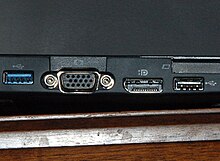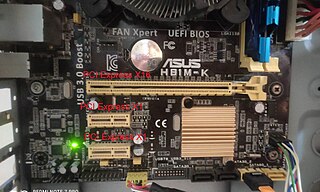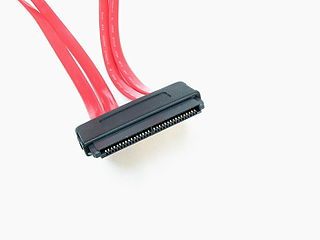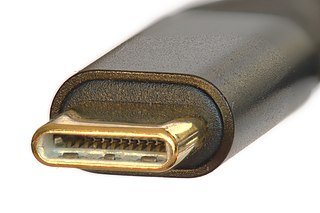 | |||
| Type | USB | ||
|---|---|---|---|
| Production history | |||
| Designed | November 2008 | ||
| Manufacturer | USB 3.0 Promoter Group (Hewlett-Packard, Intel, Microsoft, NEC, ST-Ericsson, and Texas Instruments) [1] [ dead link ] | ||
| Superseded | USB 2.0 Hi-Speed | ||
| Superseded by | USB 3.1, USB 3.2 (July 2013, September 2017) | ||
| General specifications | |||
| Length | Standard-A plug: 12 mm Standard-B plug: 12 mm Type-C (USB-C) plug: 6.65 mm | ||
| Width | Standard-A plug: 12 mm Standard-B plug: 8 mm Micro-A & Micro-B plugs: 12.2 mm Type-C (USB-C) plug: 8.25 mm | ||
| Height | Standard-A plug: 4.5 mm Standard-B plug: 10.44 mm Micro-A & Micro-B plugs: 1.8 mm Type-C (USB-C) plug: 2.40 mm | ||
| Daisy chain | No | ||
| Audio signal | No | ||
| Video signal | No | ||
| Pins | 9 (Type A & B) / 24 (Type-C) | ||
| Connector | (SS) USB 3.0 Standard-A, (SS) USB 3.0 Standard-B, (SS) USB 3.0 Micro-A, (SS) USB 3.0 Micro-B, (SS) USB 3.0 Micro-AB, USB-C (USB Type-C) | ||
| Electrical | |||
| Max. voltage | 5V | ||
| Max. current | 900 mA 1.5 A (BC 1.1/1.2, USB 3.2 single-lane) 3 A (USB 3.2 multi-lane Type-C) | ||
| Data | |||
| Data signal | Yes | ||
| Bitrate | 5 Gbit/s (500 MB/s, USB 3.0) 10 Gbit/s (1.212 GB/s, USB 3.1 Gen 2) 20 Gbit/s (2.422 GB/s, USB 3.2 Gen 2x2) | ||

Universal Serial Bus 3.0 (USB 3.0), marketed as SuperSpeed USB, is the third major version of the Universal Serial Bus (USB) standard for interfacing computers and electronic devices. It was released in November 2008. The USB 3.0 specification defined a new architecture and protocol, named SuperSpeed, which included a new lane for providing full-duplex data transfers that physically required five additional wires and pins, while also adding a new signal coding scheme (8b/10b symbols, 5 Gbps; also known later as Gen 1), and preserving the USB 2.0 architecture and protocols and therefore keeping the original four pins and wires for the USB 2.0 backward-compatibility, resulting in nine wires in total and nine or ten pins at connector interfaces (ID-pin is not wired). The new transfer rate, marketed as SuperSpeed USB (SS), can transfer signals at up to 5 Gbit/s with raw data rate of 500 MB/s after encoding overhead, which is about 10 times faster than High-Speed (maximum for USB 2.0 standard). USB 3.0 Type-A and B connectors are usually blue, to distinguish them from USB 2.0 connectors, as recommended by the specification, [3] and by the initials SS. [4]
Contents
- Overview
- Architecture and features
- Data transfer and synchronization
- Data encoding
- Power and charging
- Naming scheme
- Availability
- Adding to existing equipment
- Adoption
- Issues
- Speed and compatibility
- Radio frequency interference
- Connectors
- Pinouts
- Backward compatibility
- USB 3.1
- USB 3.2
- See also
- References
- External links
USB 3.1, released in July 2013, is the successor specification that fully replaces the USB 3.0 specification. USB 3.1 preserves the existing SuperSpeed USB architecture and protocol with its operation mode (8b/10b symbols, 5 Gbps), giving it the label USB 3.1 Gen 1. [5] [6] USB 3.1 introduced an Enhanced SuperSpeed System – while preserving and incorporating the SuperSpeed architecture and protocol (aka SuperSpeed USB) – with an additional SuperSpeedPlus architecture adding and providing a new coding schema (128b/132b symbols) and protocol named SuperSpeedPlus (aka SuperSpeedPlus USB, sometimes marketed as SuperSpeed+ or SS+) while defining a new transfer mode called USB 3.1 Gen 2 [5] with a signal speed of 10 Gbit/s and a raw data rate of 1212 MB/s over existing Type-A, Type-B, and USB-C connections, more than twice the rate of USB 3.0 (aka Gen 1). [7] [8] Backward-compatibility is still given by the parallel USB 2.0 implementation. USB 3.1 Gen 2 Type-A and Type-B connectors are usually teal-colored.
USB 3.2, released in September 2017, fully replaces the USB 3.1 specification. The USB 3.2 specification added a second lane to the Enhanced SuperSpeed System besides other enhancements, so that SuperSpeedPlus USB implements the Gen 2x1 (formerly known as USB 3.1 Gen 2), and the two new Gen 1x2 and Gen 2x2 operation modes while operating on two lanes. The SuperSpeed architecture and protocol (aka SuperSpeed USB) still implements the one-lane Gen 1x1 (formerly known as USB 3.1 Gen 1) operation mode. Therefore, two-lane operations, namely USB 3.2 Gen 1x2 (10 Gbit/s with raw data rate of 1 GB/s after encoding overhead) and USB 3.2 Gen 2x2 (20 Gbit/s, 2.422 GB/s), are only possible with Full-Featured USB Type-C Fabrics (24 pins). As of 2023, USB 3.2 Gen 1x2 and Gen 2x2 are not implemented on many products yet; Intel, however, starts to include them in its LGA 1200 Rocket Lake chipsets (500 series) in January 2021 and AMD in its LGA 1718 AM5 chipsets in September 2022, but Apple never provided them. On the other hand, USB 3.2 Gen 1x1 (5 Gbit/s) and Gen 2x1 (10 Gbit/s) implementations have become quite common. Again, backward-compatibility is given by the parallel USB 2.0 implementation.


























